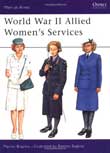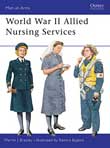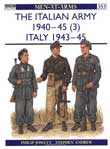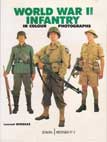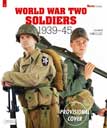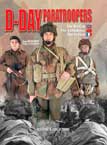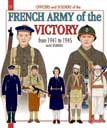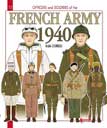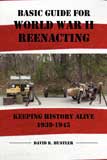

The contribution of women to the Allied war effort during World War II (1939-45) was massive. Apart from their many vital roles 'on the home front', about a million Soviet, 500,000 British and 200,000 American women, and tens of thousands from other Allied nations, served in uniform with the armed forces. To put these figures in perspective: enough American women served to free sufficient able-bodied men to form 15 infantry divisions. It was not only in the USSR that their duties took them into harm's way; hundreds of British Commonwealth and US servicewomen died, and many were decorated. This book gives a concise introduction to the organisation and uniforms of these services, with an emphasis on the British and US forces.
The skill and care of the women of the Allied military nursing services was remembered gratefully by hundreds of thousands of wounded servicemen of World War II (1939-1945). The small peacetime services increased rapidly by enrolling reservists and volunteers; the great majority of the nurses who cared for Allied casualties were 'civilians in uniform', who worked tirelessly under difficult conditions and - in tented hospitals close to the front lines - in real danger; many nurses paid for their devotion with their lives. This first-ever fully illustrated study of the US, British, Commonwealth, and other nursing organisations includes many unpublished photographs and 24 meticulously illustrated colour figures.
Immediately after the Allied invasion of Italy in September 1943, Mussolini was deposed and the new Italian government switched sides. The German occupying forces swiftly freed Il Duce and ruthlessly disarmed the Italian Army; and from then until the end of the war in April 1945 Italian troops fought on both sides--with the forces of the new Fascist 'Salo Republic', in the Allied 'Co-Belligerent Forces', and in the Partisan movement. This period of bitter struggle saw the appearance of many new units and a wide range of interesting uniforms, described and illustrated in this final part of Philip Jowett's comprehensive three-volume series.
Examines the uniforms, insignia, personal equipment and weapons of the fighting men of all major armies of World War II. Rare, original uniforms and equipment are modelled and photographed from a variety of angles. Each example is accompanied by text identifying the items illustrated.
Cutting edge when it was new--still worth having!
The armies of Scandinavia and the Low Countries bore the first crushing impact of Hitler's mighty Blitzkrieg war machine in Western Europe, in campaigns that astonished and terrified the world.
The German Wehrmacht was millions strong, equipped with the latest guns, tanks and aircraft, and had the priceless advantage of having learned the realities of modern warfare in Poland the previous September. The defenders of Scandinavia and the Low Countries were raised from small populations, and were inadequately funded, trained, equipped and armed. Their modest numbers, inexperience, and largely indefensible borders condemned them to rapid defeat - in a few hours (Denmark), a few days (Holland), a couple of weeks (Belgium), and at most two months (Norway). For this reason they have tended to be neglected by history - in many cases, unjustly. Vastly outnumbered - and, in the case of the neutral Low Countries, with their potential French and British allies reeling under simultaneous attacks - thousands of soldiers fought heroically in the hopeless defence of their homelands against the Nazi juggernaut.
Tiny Denmark had only 6,600 troops when it was invaded on 9 April 1940 by six times as many Germans with air and tank support; resistance lasted only four hours. On the same day, mountainous Norway, with 25,000 men mainly scattered in small numbers along its cliff-bound coastline, was invaded by the first elements of seven German seaborne and airborne divisions totalling 100,000 men. A British, French and Free Polish force landed to support the Norwegians, but despite the serious casualties inflicted on the German forces the country was finally forced to surrender two months later on 9 June 1940.
In the mean time the massive German Operation Yellow, undertaken by 2.75 million troops backed by strong air forces, had fallen on the neutral Netherlands and Belgium (10 May), and on France (16 May). The 250,000 Netherlands troops put up unexpectedly stubborn resistance, but were ordered to surrender on 15 May after the German bombing of Rotterdam. Belgium had mobilised some 900,000 troops, and received some help from Britain and France, but the resistance faltered as Panzergruppe Von Kleist outflanked them through the supposedly impassable Ardennes; Belgium requested an armistice on 26 May, and surrendered on the 28th. Between 26 May and 4 June the survivors of the British Expeditionary Force were evacuated from Dunkirk. On 10 June the Germans crossed the Seine; the French government fled Paris on the 12th; on the 17th Marshal Pétain requested an armistice, and France finally capitulated on 22 June.
Informed by the latest research and drawing upon archival records and period photography, this absorbing study explains the organization and combat performance and depicts the appearance of the armies of Denmark, Norway, the Netherlands and Belgium as they sought to counter overwhelming German forces in the fateful spring of 1940.
Presented here in this eighth Militaria guide are detailed color illustrations of the uniforms and equipment of combat infantrymen of WWII, displayed on live models.
Only authentic pieces from several private and public collections have been chosen for this work, and are presented on the man as they were carried on the battlefield.
Each of these 31 soldiers, Polish, Belgian, French, German, British, Italian, Russian and North American, is photographed from the front and back to reveal every detail and accompanied by detailed captions.
The very first ground actions linked to the D-Day in France were fought by the 'red berets', the famous British and Canadian paratroopers of the 6th Airborne Division dropped over the Caen region, but also the lesser-known French SAS who jumped over Brittany the same day to fight a guerilla war. This book offers every detail of these elite soldiers.
To honor the 70th anniversary of D-Day, this superlatively photographed book tells the story of the landings through more than 200 key objects carried by the men who launched the campaign. Selected for their importance to the outcome, and often arranged exactly as the participants' kits were, the artifacts include uniforms and personal mementos of such Generals as Eisenhower and Patton; blueprints of the Mulberry harbors; personal mementos of the US Rangers on Omaha Beach and British Airborne troops at Pegasus Bridge; K-rations and cigarettes, and even rare German Army and Waffen SS material collected from the Normandy battlefields. International in scope, the book covers the US, UK, Canadian, Polish, Free French, and French Resistance, along with Axis soldiers.
After the defeat in 1940, the Vichy Government started reforming the army which the occupier had been good enough to let it keep. At the same time in England, General de Gaulle got down to setting up a unit for all the volunteers drifting in from all over the Empire. Soon, after Operation Torch, the Americans started supplying the French Army in North Africa with equipment, materiel and clothing. This army of victory distinguished itself in Italy, in France and on the other side of Rhine during the last three years of the war. Discover the twentieth volume in the collection, the multifarious blend of uniforms which was such a feature of the French Liberation Army.
This, the thirteenth book in the "Officers and Soldiers" collection, shows the French Army during the Phoney War and the French Campaign in May-June 1940. Continuing the work - started two years ago by Andre' Jouineau in the two volumes dealing with the 1914-1918 armies - given over to an almost exhaustive survey of French Army uniforms and outfits during the two World Wars, this volume shows almost sixty color plates with no less than 300 uniforms, several dozen insignia and equipment illustrations.Particular attention has been paid to the description of the combat groups and the servants of the unit weapons.Andre' Jouineau, figurines maker and collector, has worked with Histoire and Collections for more than 16 years. His uniforms plates, which have been fully carried out using data processing, have made him a pioneer in this field.
In this worthy addition to the Men-at-Arms series, Martin Windrow examines the history and uniforms of the French Foreign Legion from the start of the First World War to the end of the Second World War. The author's knowledgeable text covers such topics as a comprehensive battle history of the Legion on the Western Front 1914-1918, the colonial campaigns in Morocco, Syria and Indochina, the Battle of France and campaign in Tunisia. This volume is splendidly illustrated throughout, containing a wealth of contemporary photographs and eight full page colour plates by Mike Chappell.
When Charles de Gaulle launched his celebrated appeal via the BBC on 18 June 1940, he was quite unknown to most French people. This brilliant theorist of armoured warfare--whose 1935 book Vers l'armée métier was said to have been read by Guderian--had initially been given the command of the 4e Division Cuirassée, then forming. On 6 June, by now a temporary général de brigade, he became Under-Secretary of State for War in the government of Paul Reynaud, who placed great faith in him. During those dramatic days of June, the government he joined was split between those who advocated resistance to the last, with Algiers as a temporary capital (the line supported by Reynaud and de Gaulle), and the military commanders Pétain and Weygand, who favoured an armstice, with the government remaining in France. By 16 June, with Reynaud in the minority and driven from power, the political and legal battle was lost. It was then that de Gaulle, with the decisive support of Churchill, came to the conclusion that, whatever happened, France could not stand to one side in the struggle. And so, Free France was born. In this companion volume to MAA 315: The French Army 1939-45 (I) The Army of 1939-40 and Vichy France, Ian Sumner and François Vauvillier examine the history, uniforms and insignia of the Free French, Fighting French and the Army of Liberation.
The French Army of 1939 was considered by contemporaries to be the strongest army in the world at that time. In fact, as the events of the next ten months soon revealed, the Army was riddled with fatal weaknesses. Many of these stemmed from the attitudes prevailing in the French High Command at the end of the First World War. Under Marshal Pétain (a general renowned for his care with men's lives) they were determined that the nation should never again endure such a bloodbath. They had also to evolve a strategy that took account of a predicted shortage of manpower, the so-called 'empty classes'. This was the result of a fall in the birth rate, itself the inevitable consequence of the high level of casualties during the First World War. Each of the classes called up in the years between 1935 and 1939 was some 140,000 men under strength. The French therefore adopted a defensive policy. Noting both the general success of the forts around Verdun and the efficacy of the deep dug-outs constructed by the Germans on the Western Front, the High Command evolved a plan based on the construction of a permanently fortified line along the Franco-German frontier--a line subsequently named after the Minster of War, André Maginot. This worthy addition to the Men-at-Arms series is the first of two volumes examining the French Army of the Second World War.
Poland was the first of the Allied nations to succumb to German aggression in the Second World War, but by the most tortuous of routes her army managed to remain in the field through all five years of bloody fighting. In fact by the war's end the Polish Army was the fourth largest contingent of the Allied coalition after the armed forces of the Soviet Union, the United States and Great Britain. Polish soldiers fought in nearly every major campaign in the European theatre, and their tale is a complicated and tragic one. The heroic efforts of the Polish Army were often rendered meaningless by political events far outside their control. Fate was very cruel indeed to the Polish nation during those years, and especially cruel to her soldiers. This richly detailed text by Steven Zaloga relates the story of the Polish Army during the Second World War, from the first wave of Stukas in 1939 to its eventual conclusion. Numerous contemporary photographs accompany the text, and this volume also contains eight full page colour plates by Richard Hook.
Have you ever been obsessed in war history, particularly about World War II? You have seen reenactments of that significant moment in our time that you are thinking of participating in such an endeavor. However, you don't know how to start.
Fret no more. David Hustler, a veteran of many reenactments of historical battle events, is giving you the head start by imparting tips of the ins and outs of perfecting your own impression of a soldier of the Second World War. He will guide you from buying the proper uniforms and equipments to joining your own group or units, and from the right way of caring for your costume and implements to maintaining a good attitude in the field. Avoid being called a farb on your first day as a reenactor. Follow the expert.
Pope Julius II excommunicates Italian state of Venice
Treaty of St. Truiden: anti-French Trapdoors / Bourgondisch covenant
Battle at Bicacca: Charles I and Pope Adrianus VI beat France
Mogol King Babur beats Sultan of Delhi
1st Spanish settlement in Philippines, Cebu City, forms
Peace of Beaulieu and Paix de Monsieur
King Charles I flees Oxford
Scottish general Montrose defeated
Netherlands and France sign military covenant
Frederik August I "the Strong" becomes Monarch of Saksen
Battle at Culloden Moor: Duke of Cumberland beats "James VIII & III"
US Marines attack shores of Tripoli
Americans under General Pike capture Toronto; Pike is killed
Fire destroys half of Charleston
Imakita Kosen, 1st Zen teacher of D.T. Suzuki, found the awakening
Establishment of Jewish congregations in Lower Austria prohibited
"Pomona" sinks in North Atlantic drowning all 400 aboard
Thomas J Jackson is assigned to command Harpers Ferry
President Abe Lincoln suspends writ of habeas corpus
West Virginia secedes from Virginia after Virginia secedes from US
Cornell University (Ithaca NY) is chartered
Heinrich Schliemann discovers Troi
White League, Paramilitary white supremacist organization, forms
Opera "Le Roi de Lahore" is produced (Paris)
President Hayes removes Federal troops from LA, Reconstruction ends
Pogroms against Russian Jews start in Elisabethgrad
1st Highlander (Yankee) shut-out, Philadelphia Athletics win 6-0
World Exposition opens in Luik
Sultan of Turkey Abdul Hamid II is overthrown
Belgian parliament rejects socialist motion for general voting rights
Relief laws replaces those of 1854, in the Netherlands
Pogrom leader Petljoera declares Ukraine Independence
Hadjememaar, [Corn de Gelder] elected in Amsterdam
Fritz Langs "Dr Mabuse, der Spieler" premieres in Berlin
Yakut ASSR formed in Russian SFSR
Mussolini government italian place in South Tirol / Alto Adige
Antwerp soccer tie Belgium-Netherlands 1-1
Karl Jansky reports reception of cosmic radio signal in Washington DC
Yanks pull a 1st inning triple-play and beat Philadelphia Athletics 9-8
1st US social security payment made
US Social Security system makes its 1st benefit payment
Himmler orders establishment of Auschwitz Concentration Camp
German troops occupy Athens Greece
Belgium Jews are forced to wear stars
Tornado destroys Pryor Oklahoma killing 100, injuring 300
Lou Jansen and Jan Dieters arrested, lead illegal CPN party in Holland
Soviet Union breaks contact with Polish government exiled in London
Boston Brave Jim Tobin no-hits Brooklyn Dodgers, 2-0
2nd Republic of Austria forms
Italian partisans capture Mussolini prisoner
US 5th army enters Genua
1st radar installation aboard a coml ship installed
Babe Ruth Day celebrated at Yankee Stadium and through out US
Arab legion attacks Gesher bridge on Jordan River
"Tickets, Please" opens at Coronet Theater NYC for 245 performances
South Africa passes Group Areas Act segregating races
Mohammed Mossadeq chosen Premier of Persia
"4 Saints in 3 Acts" closes at Broadway Theater NYC after 15 performances
1st general elections in British Guyana, won by Jagans PPP
Wrestler Freddie Blassie coins term "Pencil neck geek"
Heavyweight champ, Rocky Marciano, retires undefeated from boxing
"Today" show goes abroard 1st time (Paris France)
Liu Sjau-chi elected President of China PR
1st atomic powered electric-drive submarine launched (Tullibee)
South Korean President Syngman Rhee resigns
Togo (formerly French Togo) declares independence from French adm
NASA launches Explorer 11 into Earth orbit to study gamma rays
NFL officially recognizes Hall of Fame in Canton, Ohio
Sierra Leone declares independence from the UK
"Jopie" Pengel forms government in Suriname
Cuban Premier Fidel Castro arrives in Moscow
RC Duncan patents "Pampers" disposable diaper
Dmitri Shostakovitch completes his 2nd cello concert
Rocky Marciano retires as undefeated boxing champ
"Education of Hyman Kaplan" closes at Alvin NYC after 28 performances
Baltimore Oriole Tom Phoebus no-hits Boston, 6-0
Congress of Political Party Radicals (PPR) forms in the Netherlands
Carol Mann wins LPGA Raleigh Ladies Golf Invitational
Curt Flood resigns Senators after 13 games and departs for Denmark
Apollo 16 returns to Earth
New York City Mayor John Lindsey appeals that John Lennon not be deported
Kansas City Royal Steve Busby no-hits Detroit Tigers, 3-0
Pan Am 707 crashes into mountains of Bali, killing 107
Sandra Haynie wins LPGA Charity Golf Classic
"So Long 174th St" opens at Harkness Theater NYC for 16 performances
Arabic Monetary Fund established in Abu Dhabi
Bloody riots in Soweto South Africa
HCC, Hobby Computer Club, forms in the Netherlands
Accident at nuclear reactor Willow Island, W Virginia, kills 51
George Harrison releases "Love Comes to Everyone"
Barbara Barrow wins LPGA Birmingham Golf Classic
1st female soccer official is hired by NASL
Beatle Ringo Starr marries actress Barbara Bach [Goldbach]
Nordiques 1-Isles 4 - Semifinals - Isles hold 1-0 lead
Trial of John W Hinckley Jr attempted assassin of Reagan, begins
Nolan Ryan becomes strikeout King (3,509), passing Walter Johnson
Cleveland Indians beat Detroit Tigers, 8-4, in 19 innings
Over 70 inches of snow falls on Red Lake, Montana
"Sweet Charity" opens at Minskoff Theater NYC for 368 performances
Captain Midnight (John R MacDougall) interrupts HBO
Pat Bradley wins LPGA S&H Golf Classic
US Justice Department bars Austrian Chancellor Kurt Waldheim from entering US, due to his aid of Nazi Germany during WWII
"Starmites" opens at Criter Ctr SR Theater NYC for 60 performances
Beijing students take over Tiananmen Square in China
Hurricane in Bangladesh, kills 500
Mandatory seatbelt law goes into effect in Italy
50th annual barbershop quartet singing convention held (Mich)
Dodger Orel Hershiser undergoes career-threatening shoulder surgery
Firestone World Bowling Tournament of Champions won by David Ozio
"Small Family Business" opens at Music Box Theater NYC for 48 performances
New York Jets finish perfect 5-0 pre-season for 1st time
New York Mets trade David Cone to Toronto Blue Jays for Jeff Kent
Afghan Antonov AN-32 crashes at Tashqurgan, kills 76
"Inspector Calls" opens at Royale Theater NYC for 454 performances
7th longest NHL game: New Jersey Devils beat Buffalo Sabres (125 min 43 seconds)
Graeme Obree bicycles world record time (52,713 km)
President Nixon buried in Nixon Library in California
Twins righty Scott Erickson no-hits Brewers 6-0
"Indiscretions" opens at Ethel Barrymore Theater NYC for 221 performances
Coors Field in Colo opens - Denver Rockies beats Mets 11-9 in 14
"Little Foxes, " opens at Vivian Beaumont NYC for 56 performances
"Stanley, " closes at Circle in the Square Theater, New York City
Frank Nobilo wins Greater Greensboro Chrysler Classic at Forest Oaks
Las Vegas Senior Golf Classic by TruGreen-ChemLawn
Nancy Lopez wins LPGA Chick-fil-A Charity Championship
